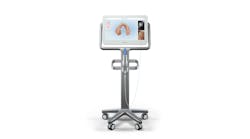I started my journey in digital dentistry in 2011. Coming up on 10 years now! It seems like only yesterday . . . until I think about the technology and capabilities my first scanner had. It was a one-trick pony. It could be used only for restorative procedures. Not just any restorative procedures, it could be used only for fixed restorative procedures. It required powder. It only scanned in black and white. In retrospect, it was a dinosaur.
Obviously, technology evolves, and fortunately for us, intraoral scanners have become investments for our practices that affect far more than just fixed restorative procedures. Digital scanners such as the new iTero Element 5D imaging system are very valuable utility players in our modern practices, affecting almost every patient we see.
The iTero Element 5D is the newest offering in a long line of intraoral scanners from Align Technology. The iTero, in some form, has been around for more than a decade. First known under the name Cadent, iTero scanners were early players in this game. Align continues to innovate with the iTero Element 5D, which adds “a new spectrum” of information.
The Element 5D is the first scanner to have near-infrared imaging (NIRI) on board. NIRI allows you to scan the internal structure of teeth in real time. This means that you can do caries detection while you scan. Caries detection units by themselves can cost thousands of dollars and add on cumbersome equipment and time to operate. Having one integrated into a piece of equipment that we use on every patient anyway adds a new dimension of communication between me and my patients.
In my practice, we do an iTero Element scan on every new patient we see. We do this for multiple reasons, but it always comes down to communication. When I can give patients a 3-D tour of their mouth, they are always wowed. They remember that experience. Plus, they understand what I am trying to educate them about much quicker. Add caries detection into the new iTero Element 5D, and I can have a multidisciplinary discussion with patients more easily than ever.
In addition to the NIRI technology, the Element 5D has all the iTero bells and whistles you are used to: integration with Invisalign, including an outcome simulator and progress assessment, and a full array of restorative workflows.
Timelapse is another frequently used feature in my office. We use it to monitor things such as wear and recession down to the micron. The display of these issues in Timelapse helps to convey the disease process to patients so that they understand the urgency.
The iTero Element 5D comes in a couple of different configurations—the traditional iTero wheeled stand with attached monitor and as a stand-alone wand to pair with your laptop, which must meet minimum standards. As with most intraoral scanners, a monthly data fee applies.
The iTero Element 5D brings another level of data into my scans with its NIRI caries detection technology, opening the door for me to have even better and deeper conversations with my patients while showing them the evidence of their dental condition. That’s a solo home run for me!
Joshua Austin, DDS, MAGD, writes the Pearls for Your Practice column in Dental Economics. After graduating from the University of Texas Health Science Center Dental School, Dr. Austin associated for several years. In October of 2009, he opened a solo general practice in a suburban area of San Antonio, Texas. Dr. Austin is involved in all levels of organized dentistry and can be reached at [email protected].







